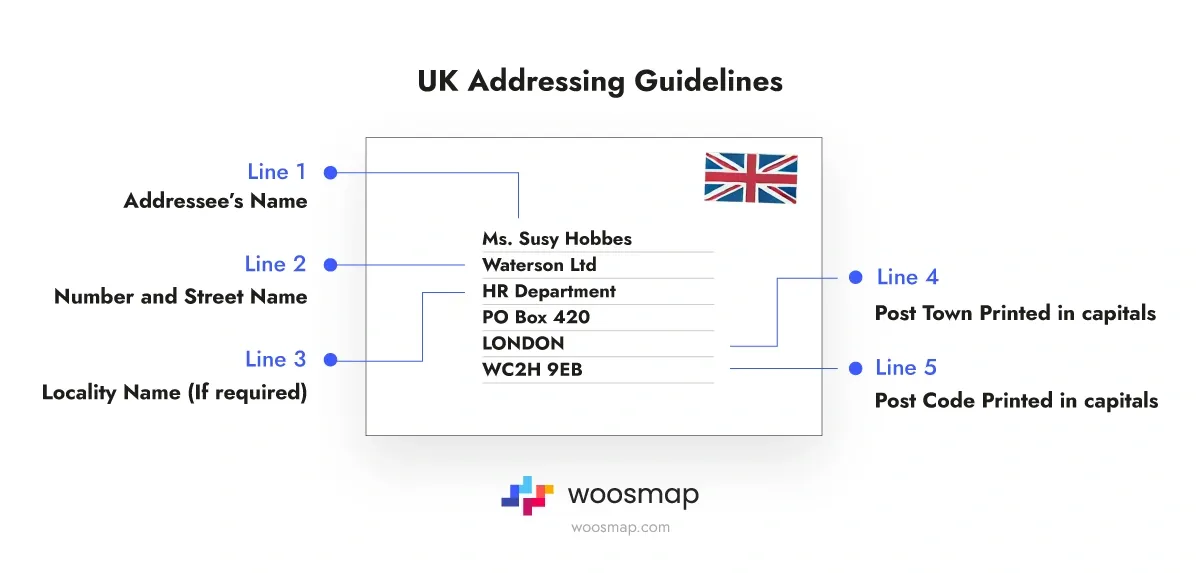UK Address Guide: Decoding Postal Codes & Formats
Ensuring your mail or packages reach their destination in the United Kingdom requires a grasp of the correct address format. The UK's address system, overseen by Royal Mail, demands adherence to specific guidelines to prevent delays or misdelivery.
It doesn't matter if your mail is headed to a friend in London or a business in Edinburgh, mastering the correct UK address format is key. We'll explore the nuances of the UK postal code system, address formats, and how to handle any peculiarities or exceptions.
For example, when sending a letter to John Smith in London, it's important to include the house number and street name, followed by the post town and postcode, in a Royal Mail-friendly format. This means placing the town and postal code on separate lines, omitting commas or full stops, and left-aligning the text. Attention to these details significantly impacts the delivery process.
In subsequent sections, we'll offer comprehensive examples and advice to perfect your UK address formatting skills. Whether you're sending mail regularly or just occasionally, this guide will ensure your shipments are precise and timely.
Understanding the UK Postal Code System
What is a Postal Code?
A postal code, often referred to as a postcode in the UK, is a distinctive sequence of letters and numbers designed to aid in the efficient sorting and delivery of mail. This system, unlike the United States' zip code system, incorporates both letters and numbers, enabling the identification of smaller geographic areas with greater precision.
Managed by Royal Mail, this system enhances the mail delivery process by dividing the country into smaller, manageable segments.
Breakdown of the UK Postal Code
The UK postal code consists of two primary components: the outward code (or outcode) and the inward code (or incode), which are separated by a single space. Here’s an in-depth look at each component:
Outward Code (Outcode): The outward code helps in directing mail to the appropriate local sorting office by identifying a broader geographic area. It is usually composed of two to four characters, representing the postcode area and the district. For instance, in the postcode "SW6 3AZ", "SW" signifies the postcode area (London) and "6" indicates the district within that area.
Inward Code (Incode): Utilized by the local sorting office, the inward code directs mail to the exact street or building. It begins with a numeric character followed by two letters. In the "SW6 3AZ" example, "3AZ" is the inward code, where "3" denotes the sector within the postal district, and "AZ" specifies one or more properties within that sector.
The UK postal code system is structured across four levels: Area, District, Sector, and Unit. Here’s the functionality of each level:
- Area Postcodes: Represented by the first part of the outward code, usually two letters, indicating one of the 124 postcode areas in the UK (e.g., "SW" for London).
- District Postcodes: The subsequent part of the outward code, possibly one or more numbers, identifies the district within the area (e.g., "SW6").
- Sector Postcodes: The first character of the inward code, in combination with the district, defines the sector (e.g., "SW6 3").
- Unit Postcodes: The final two characters of the inward code identify a specific group of houses, a single address, or a large user (e.g., "SW6 3AZ").
Grasping these elements is vital for the correct formatting and use of UK postcodes, ensuring mail is delivered promptly and to the correct destination.
Formats of UK Addresses
Typical Components of a UK Address
A UK address is composed of several key components, each serving a specific purpose in ensuring the mail reaches its intended destination. Here are the typical elements you would find in a UK address:
- Addressee Line: This includes the recipient's name, and if applicable, their title. For example, "Mr. John Smith" or "Mrs. Jane Doe".
- Organization or Department Name: If the mail is addressed to a business or organization, this line includes the company name and, if relevant, the department name. For instance, "Dunder Mifflin Printers Ltd" or "IT Department".
- Unit, Apartment, or Flat Number: If the address includes an apartment, flat, or unit number, this information is provided here. For example, "Flat 10" or "Suite 5".
- Building or House Number and Street Name: This line contains the house or building number along with the thoroughfare (street name). It may also include a dependent locality or double-dependent locality if necessary. An example would be "20 Prince Street" or "10 Carter Street".
- Post Town (City): The post town or city name is written in all capital letters and is an important part of the address. For example, "LONDON" or "NORWICH".
- Postcode: The postcode, as discussed earlier, is a combination of letters and numbers that helps in precise delivery. It is also written in all capital letters and is placed on a separate line from the post town. An example would be "SW4 0SB" or "NR1 1BG".
Example Addresses
To illustrate the correct formatting of UK addresses, here are a few examples:
Residential Address Example:
Mr. John Harisson
10 Carter Street
NORWICH
NR1 1BGThis example shows a typical residential address with the recipient's name, house number and street name, post town, and postcode.
Business Address Example:
Mr. Peter Griffin
Dunder Mifflin Printers Ltd
Bane Towers
24 Myton Rd
STOCKTON-ON-TEES
TS17 0WAThis example includes the company name, building name, street details, post town, and postcode, which are essential for business addresses.
PO Box Address Example:
Ms. Susy Hobbes
Waterson Ltd
HR Department
PO Box 420
LONDON
WC2H 9EBFor PO Box addresses, the PO Box number, company name, department name (if applicable), post town, and postcode are included.
These examples highlight the importance of each component and how they should be formatted to ensure accurate and efficient delivery of mail in the UK.
Navigating Address Variations and Exceptions
Rural and Non-Standard Addresses
In the UK, rural and non-standard addresses often pose unique challenges compared to urban addresses. In urban settings, simply providing the city name might suffice, but rural addresses typically demand more detailed information to guarantee precise delivery.
Important considerations include:
In rural locales, it's usual to mention a dependent locality or double-dependent locality for more specific location details. For instance, an address may read "The Village, Littleton," before listing the post town and postcode, aiding in the differentiation of similarly named localities within the same administrative region.
Rural addresses might also require the mention of sub-provinces or other administrative divisions to prevent confusion, especially vital in areas where localities of the same name exist but in different parts of the country.
Additionally, it's important to recognize that some addresses may be known by various names across different databases or among local residents. A road known as "S Hwy X" in one record might be "South County Rd X" in another. Address formatting consistency is key to avoiding such discrepancies.
PO Boxes and Special Addresses
PO Boxes and special addresses in the UK adhere to specific guidelines:
For PO Box addresses, the format generally includes the recipient's name, optionally the company and department names, followed by the PO Box number, post town, and postcode, as in:
Ms. Jane Doe
Marketing Department
PO Box 1234
LONDON
WC2H 9EBThis arrangement ensures mail is correctly routed to the intended PO Box and, if applicable, to the right department or individual within that box.
Special addresses, like those for houseboats or new housing developments, might need extra details for successful delivery. Houseboat addresses could require the marina or dock name, whereas new developments may use temporary postcodes until permanent assignments.
Occasionally, addresses may receive temporary designations, such as those for construction sites or new buildings. Royal Mail's "Not Yet Built" database product addresses these situations, enabling mail delivery to these locations as soon as they are officially recognized.
Conclusion
In wrapping up, it's paramount to grasp and properly format UK addresses for the sake of efficient mail delivery. Remember the critical components of a UK address, which include the premise identifier, street details, post town, and postcode.
The postcode is especially important, as it contains the bulk of the address's information. It should always be in uppercase letters with correct spacing. Refrain from adding superfluous details like county names, and ensure the post town is also in uppercase letters.
Adhering to these guidelines guarantees that your mail will be delivered promptly and to the right location. Validate your addresses using resources such as the Royal Mail's Postcode Address File or other address validation services to ensure accuracy.
Equipped with these tips, you'll be adept at navigating the UK's address system with ease.
FAQ
What is an example of a UK address?
An example of a UK address:
Mrs Smith
71 Cherry Court
SOUTHAMPTON
SO53 5PD
UNITED KINGDOMWhat is a valid address in the UK?
A valid UK address includes a premise identifier (such as a building number, name, or organization), street details, post town (in uppercase), and a postcode (in uppercase and correctly spaced). It should not include unnecessary details like county names, and the postcode should be on the last line.
How is a UK address formatted?
A UK address format includes:
- Addressee's name
- House number and street name (or building name)
- Locality name (if needed)
- POST TOWN (in capital letters)
- POSTCODE (in capital letters, on a separate line)
- UNITED KINGDOM (in capital letters, for international mail)
What is an example of Address 1 in the UK?
For a UK address, here is an example:
Mrs Smith
71 Cherry Court
SOUTHAMPTON
SO53 5PD
UNITED KINGDOMAbout Woosmap
Woosmap empowers businesses to optimize Location Services and Intelligence with precision and efficiency. By leveraging advanced geolocation, Store Locator, and Map API tools, Woosmap ensures accurate deliveries, streamlines address entry processes, and enhances customer satisfaction. With a strong commitment to privacy, Woosmap delivers innovative, GDPR-compliant solutions that do not collect personal data, making it a trusted partner for companies prioritizing both performance and user trust.

